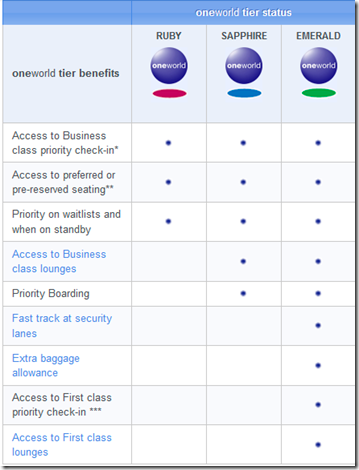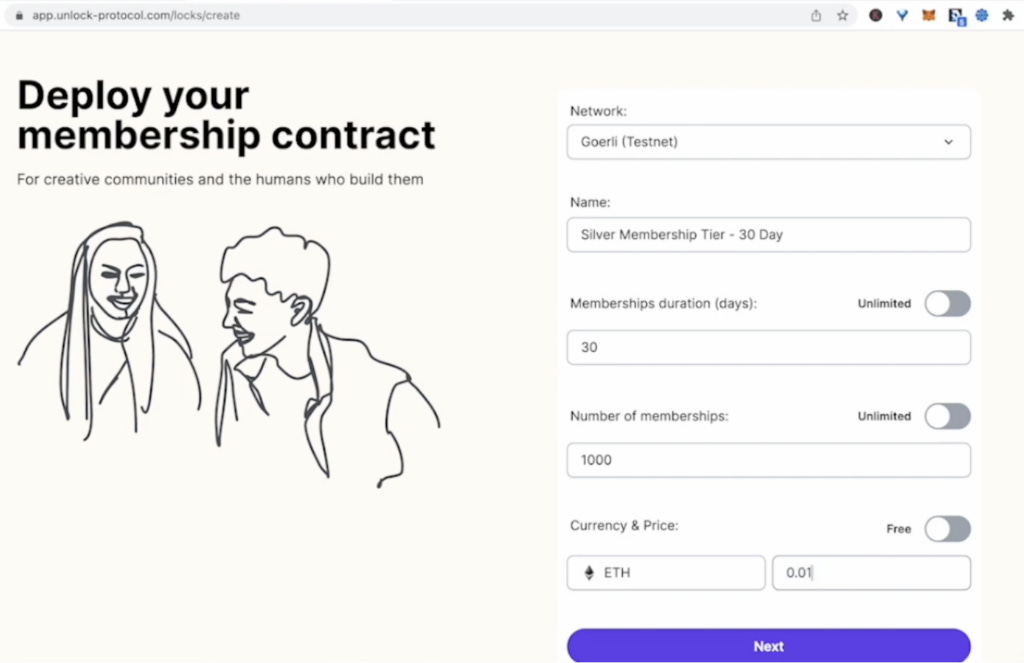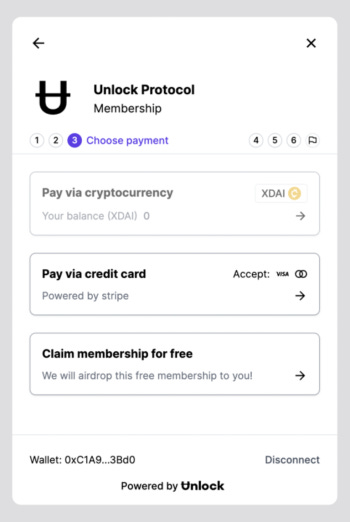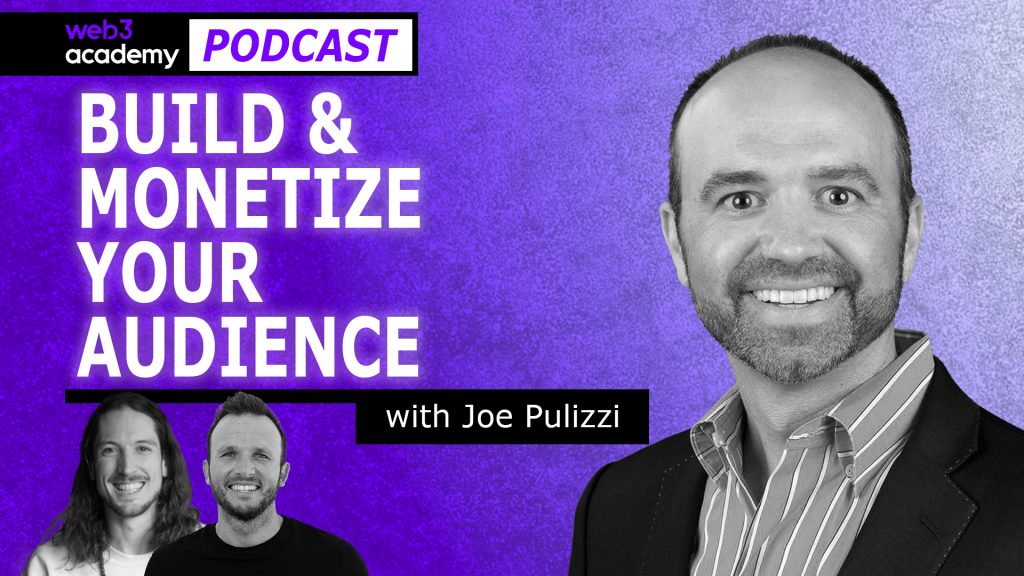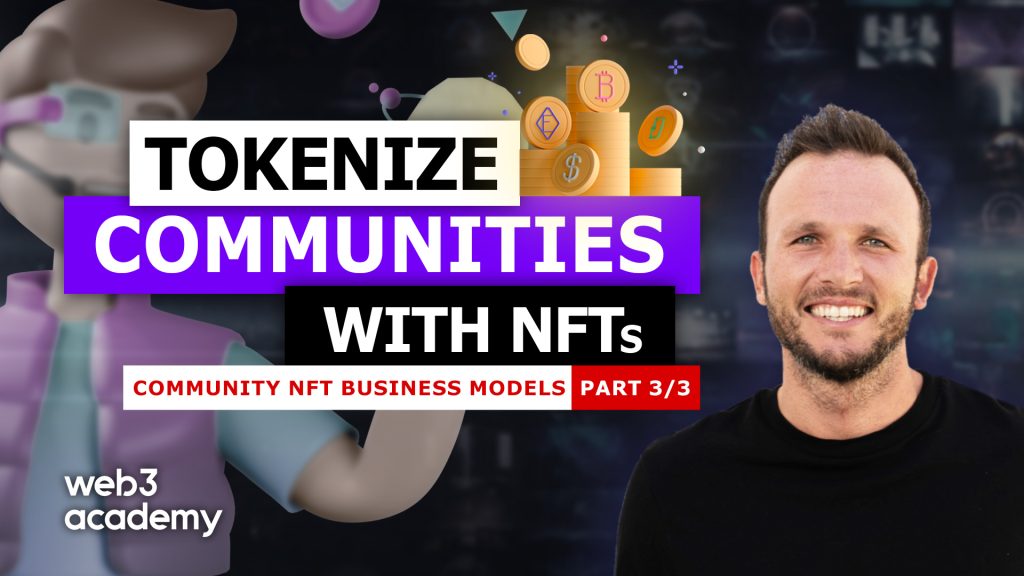
How To Create a Membership Program with Unlock Protocol
NFT memberships are the future, don't get left behind
No time to read? Learn how to create a membership program through your favorite podcast platform 👇
GM DOers!
There’s no doubt that NFTs will become the de-facto technology used for memberships and subscriptions in the future.
But that doesn’t mean the program you build will be successful simply because it uses web3 tech. Quite the contrary actually.
Yes, NFTs do unlock a host of extra use cases thanks to interoperability and the transparency of blockchains. But they’re only one piece of the puzzle. First, you need to know how to structure your membership program. 👷♀️
And to share the playbook with you, we’ve got this Deep Dive courtesy of NFT membership experts, Unlock Protocol.
In this guide, they break down:
- What memberships are and what makes a successful program 📈
- How to think about your membership tiers and benefits 🤔
- Measuring the success of your program 🎉
- Technical examples that show you exactly how to create your membership 🛠️
By the way, if you didn’t see it already, Web3 Academy is looking for a Social Media Intern! So if you know your way around memes and shit posting, follow the instructions in this tweet.
Now, let’s dive in!

VERIFY, DON’T TRUST
Did the music NFT bubble just pop? Find out in our latest PRO report where we break down everything happening in the ecosystem.
Note: If you’re not a PRO DOer, you’ll only get a brief peek into the state of music NFTs. But if you want to know exactly what’s happening, you know what to do: Go PRO.
First, Let’s Start With the Basics
A membership program allows individuals or organizations to become “members” in exchange for certain access, benefits, or privileges.
Some membership programs offer access to exclusive events or content, discounts on products or services, or other perks for members. 🎁
Membership programs can be used by organizations or projects as a way to engage loyal customers and encourage them to continue using their products or services.
This same concept of membership can drive revenue as well; paid members-only access to benefits can be a core part of an organization’s business model. For example, a staggering 80% of Costco’s profits come from its membership fees, totaling $3.9 billion in 2021.
But what does it mean to be a member of something?
At its core, membership means belonging. Being a “member” means that you’re part of a community of like-minded individuals. 🧑🤝🧑
Membership in a group or community can provide a sense of purpose and belonging. This sense of belonging can help people feel more confident, capable, and connected.
The positive emotional feeling of membership and belonging is an important aspect of the human experience and contributes to an individual’s sense of well-being and happiness.

Being a member of something also means you have access to resources and opportunities that may not be available to non-members.
For example, the membership “benefits” of being part of a book club can be around human connection and having the ability to regularly interact with others around a shared passion in a comfortable space.
At a practical level, the benefits or privileges that come with membership can vary widely depending on the specific organization.
Membership at a gym grants you the access to connect with other people who are focusing on fitness as well as access to discounted rates on fitness classes and use of the gym facilities. 💪
In other instances, being a member of a professional organization might give you access to networking events and industry resources.
But Wait, What’s the Difference Between a Membership and a Subscription?
Mechanically and technically, memberships and subscriptions are similar, and the differences come down to the concepts of time and recurrence, as well as belonging.
Memberships can be of any length of time. For instance, some memberships are perpetual. With perpetual memberships, access to membership benefits lasts forever, with no additional payment or effort required. ✅
Perpetual memberships are very difficult to sustain if any type of funding or expense is required from the organization in order to continue providing benefits to members.
With more sustainable membership programs, having a membership often involves a fee that is paid on a periodic basis (such as annually or monthly) in order to maintain membership in the organization.
This fee may provide access to certain benefits or privileges, such as discounts on products or services, access to exclusive events or resources, or the ability to participate in decision-making processes.
Memberships that have monthly, yearly, or other periodic membership fees can become self-sustaining. ♻️
A subscription usually refers to paying for ongoing access to a product or service, such as a newsletter, a streaming service, or a software program.
The subscription may be for a fixed period of time (for example, a year), or it may be an ongoing arrangement where the customer is charged on a regular basis (such as monthly or annually) until they choose to cancel the subscription.
The main difference between a recurring membership and what is commonly referred to as a subscription is that feeling of belonging.

“Members” typically feel a connection with other members in the same group, whereas a group of “subscribers” to the same service may not be aware of each other.
However, at a technical level, time-bound memberships, recurring memberships, and subscriptions can be built with similar components, such as the capabilities provided by Unlock Protocol.

QUESTION
Do You Think Memberships Are More Successful Than Subscriptions?
- Absolutely! It’s all about the connection.
- Nah, it’s the same for me.
👉 Let us know by dropping a comment below! Bonus points if you share your favorite memberships.
How to Build Your Membership Program
Building a sustainable and effective membership program is about more than just selling access NFTs.
You need to consider:
- Who should be eligible to join your program
- What privileges, benefits, and tiers will make up your membership
- The role status plays in your program
- How to measure your success
Let’s break them down.
How Can You Determine Eligibility for a Membership Program?
Determining “eligibility” is about setting up requirements or limitations for who can join the program. ⛔
This can involve setting specific eligibility criteria, such as requiring a certain level of experience or education, or requiring that an individual meet certain age or residency requirements.
But it can also involve setting fees or charging for membership, or requiring that members meet certain expectations or obligations in order to maintain their membership. 💸
There are several ways to determine eligibility for a membership program.
For example, an organization might require individuals to apply for membership and go through a review process before being accepted.
This can help the organization ensure that only qualified individuals are granted membership, and can also help the organization identify individuals who are particularly interested in or committed to the organization’s mission.
Another way to structure a membership program is by offering different levels of membership, with each level offering a different set of benefits and privileges.

This can allow the organization to reward its most loyal or committed members with additional perks and incentives, while still offering a range of options for individuals who may be interested in becoming members but may not be able to commit to the highest level of membership.
Airline mileage programs typically gate their various levels of membership benefits based on usage of their service over the most recent year.
Finally, gaining access to membership may be entirely financial in nature.
In these cases, one becomes a “member” solely by purchasing access to the membership, with no other commitment or criteria required.
These types of memberships are very transactional in nature, and “members” may be more likely to leave or churn if their financial situation changes or if they don’t feel they are getting value out of the “benefits” they believed they were purchasing.
Finance-only gating also has the weakest connection between members themselves, as members may not share any traits with each other besides the fact that they all were able to pay the membership fee. 😬
Overall, thoughtfully determining eligibility or requirements of a membership program can help an organization attract and retain the right members.
It can also help ensure that the program attracts the right members to be successful and sustainable over time.
Traits of Successful Membership Programs
There are several traits that can contribute to the success of a membership program.
Some of these include:
1. A Clear Reason to Join
A successful membership program should offer clear and compelling value to its members. This may be based on interpersonal, “belonging” benefits, and can also include exclusive access to products or services, discounts, or other perks that are valuable to members.
For example, a gym membership program might offer discounts on fitness classes and access to a variety of equipment, which would be valuable to individuals interested in maintaining a healthy lifestyle. 💪
2. A Sustainable Membership Model
A successful membership program should be sustainable and able to meet the needs of both the organization and its members over the long term.
This could involve carefully managing the size of the membership program and ensuring that it is financially viable over time through having an ongoing revenue model beyond a one-time entry fee.
3. Thoughtful Community Management
In membership communities that include peer-to-peer interactions, active and thoughtful member and community management is a must.
Members should be “onboarded” to understand the ethos of the community, an effort should be made to keep interactions civil between members, and conversations should be brought back “on track” if they drift too far from the topics at hand. 🛣️
On the other hand, if the member benefits are purely transactional in nature, members should have access to high-quality customer service, including prompt responses to questions and concerns and access to helpful and knowledgeable staff.
4. Levels, Flexibility, and Customization
A successful membership program should offer flexibility and customization to meet the needs and preferences of different members.
This could include offering different levels of membership with different benefits or allowing members to tailor their membership to their specific needs.
5. An Efficient and User-Friendly Enrollment Process
If a project is aiming to gather a large membership, the enrollment process should be efficient and easy to navigate, so that potential members can quickly and easily become members.
6. Strong Marketing and Outreach Efforts
Similarly, if the goal of the membership program is to scale, the program should have strong marketing and outreach efforts to attract and retain members.
This could include engagement on social media, email marketing campaigns, advertising campaigns, or other types of awareness and growth strategies.
Note: Not all memberships need this. If the goal of the membership is to curate a small and tight-knit community of members, organic growth is preferable to large campaigns that attract a mass audience.

SOCIALS
Meme of the Week
Thinking About Your Membership Identity and Benefits Stack
When you are putting together your membership program, there are several dimensions to consider, including identity, privileges, and benefits.
Membership and Identity
Thinking through identity is somewhat elusive, yet it’s a critical part of defining the feeling and “core” of your membership.
What do members call themselves?
How do they recognize each other if they were to see each other on the subway or on the street?
Is there a name? Is there a logo? Is there a vibe?

Here’s what Sara Lester, a fan of the band Phish had to say about her membership in the “Phishhead” community.
“The first thing I notice as I pull into the parking lot and park my car is the energy of these people. Massive amounts of tie-dye and flowy dresses flood my view.
I watch mesmerized at the colorful hula-hoops, barefoot toes dancing, and the contagious laughter of everyone. Music fills the scene, hugging old friends and new ones, catching up on life between shows, reminiscing about past shows and memories and visibly excited of what’s to come.
I breathe deep and feel the dirt beneath my feet, look around and feel an immense sense of being home, and that’s when it hits me – I have found my people…”
This is exactly the kind of feelings that you want to invoke with your membership. Although, it doesn’t need to include tie-dye clothes or barefoot dancing!
The key lesson here is that strong membership is tribal. 🔥
As you are developing your membership program, think through the example above.
Do your members have a name they call themselves? For example, members of the Unlock Protocol community refer to themselves as “Locksmiths.”
Are there logos or another visual iconography that someone would wear to show their membership in the tribe? Are there rituals in which members regularly participate?

While the Phish example above illustrates a kind of membership community that has been growing for over two decades, you can apply these same principles around membership identity to your membership program as well.
Membership Privileges, Benefits, and Tiers
Membership programs typically have privileges and benefits.
As you are thinking through your membership program, there are a few reasons why you may consider starting with a single membership tier with a single set of privileges and benefits:
- Simplicity: Starting with just one tier can make the membership program simpler and easier to manage, especially if you’re just starting out. It can also be less confusing for potential members, as they won’t have to choose between multiple different levels of membership.
- Investment of time and complexity: Offering multiple tiers of membership can require additional time and resources, as you’ll need to create and implement different levels of content and benefits for each tier. By starting with just one tier, you can focus on creating high-quality content and benefits that will appeal to your membership, without having to worry about the complexity and management of creating multiple levels of privileges and benefits.
- Feedback and learning: Starting with a single membership tier enables you to gather feedback from your initial members and use it to improve the membership program. This can help you to identify what works well and what doesn’t, and allow you to make any necessary adjustments before adding additional tiers.
Starting with a single tier can be a good way to test the waters and see how your membership program is received before committing to offering and investing in creating multiple levels of membership.
But as your program grows, you may consider adding additional tiers, with additional privileges and benefits. 📈
For example, most airline membership programs have multiple tiers and grant increasing privileges and benefits for the higher tiers.
Regardless of whether you start with one tier or multiple tiers, Unlock can help. Unlock natively supports any number of membership tiers, each with its own smart contract.
Different Kinds of Privileges and Benefits You May Offer
Whether your membership program has one tier or many, you’ll need to think through different types of privileges and benefits that members may get.
In setting up that benefits stack, you can think through things using a model defined by Gabe Zichermann, a gamification expert and author who has developed a framework called the “S.A.P.S.” model to help organizations design effective gamification strategies.
The S.A.P.S. model stands for:
- Status: This refers to the social recognition and status that people receive as a result of their actions. Status can be used to create a sense of accomplishment and reward people for their contributions.
- Access: This refers to the exclusivity or special privileges that are granted to people as a result of their actions. One of the key benefits of membership is exclusive access to people, resources, or experiences that are not afforded to non-members.
- Power: This refers to the influence that people have as a result of their membership.
- Stuff: This refers to the tangible rewards that people receive as a result of their actions. Membership can be used to reward people with tangible rewards such as prizes, merchandise, swag, or discounts.
The S.A.P.S. model suggests that a complete definition of a benefits stack may motivate and engage members by offering them a combination of social recognition, exclusivity, control, and tangible rewards.
The Importance of Status
As you are defining your membership program, note that membership can convey status.
For some individuals, status in a membership program can be a significant motivator.

Members who are motivated by status may be more likely to continue their membership if they feel that they are making progress and advancing through different levels of status over time.
Status also can provide incentives for individuals to engage more.
Members may be more likely to increase their level of engagement or investment in order to reach higher levels of status and unlock additional benefits.
Benefits In the Form of Access, Power, and Stuff
After status, “access” is the most frequent benefit offered to members for many membership programs.
Access benefits can include:
- Access to members-only conversations in Discord, Telegram, or other online community hubs
- Access to ticketed, in-person events
- Access to exclusive, members-only content on a WordPress or other website
- Access to “behind the scenes” videos or live streams
- Access to members-only newsletters
- Access to exclusive events with founders or well-respected members of the community
- Access to allowlists or pre-sales
- Access to discounts on swag or e-commerce items
- Access to “VIP” areas at a live, in-person event
- Access to a directory of fellow members of the community
Note: The list above is illustrative, and not exhaustive.
Similar to status, access is a powerful motivator for membership.
As you are thinking through the definition of your benefits stack, status and access are the two aspects that will be the most significant in your program’s importance to its members.
“Power” is the next level of the benefits stack. Can members invite others to join, or confer benefits on them?
Finally, benefits may include “stuff” in the form of swag or other tangible items. 👓
Undifferentiated, unbranded “stuff” is fungible and is not typically a strong motivator. On the other hand, project-branded items, unique items, or items that convey status can be viewed as valuable to members, especially when there is a strong group identity.
Measuring Success
Earlier, we discussed key traits of successful membership programs.
These include having a clear benefit to members, a sustainable model for you (where expenses, if any, are covered over time), and other traits.
A sustainable membership program has a way to measure and track its progress.

Note: This doesn’t necessarily need to be in spreadsheets or completely quantitative, but you should put some thought into where you want the membership to be in the future.
Where do you want it to be in a year? In three years?
You could measure this in a number of ways:
- Number of members
- Rate of member growth
- Engagement of membership
- Member contributions
- Sustainable revenue
- Churn in the membership
- “Vibes”
Defining Your Membership Terms
You’ve thought about a lot of things so far with regard to your membership program. Now, it’s time to use Unlock to make it a reality.
There are a few items you’ll need in order to set up the smart contract(s) for your membership.
These include:
- Number of tiers: Will your membership have one tier or multiple tiers?
- Duration: How long does a membership last? A month? A year? Forever?
- Size of membership: Is there a maximum number of members that the program can have? This becomes important when memberships are used for event ticketing based on the size of the venue.
- Cost: Does the membership have a cost? Is it free?
- Recurring subscription: If paid, does the membership renew automatically and turn into a recurring paid subscription?
- Identity: What is the name of your membership? Do you have art or a logo?
- Benefits stack: Using the “S.A.P.S.” model, what are the privileges and benefits for each tier?
Next, we’ll learn how to use Unlock to deploy the smart contracts to manage your memberships!
The Technical Side of Building a Membership
Unlock Protocol enables users to create and deploy membership smart contracts (we call them “Locks”) that can be used to mint NFTs (we call them “Keys”) to convey status and grant access to membership benefits or privileges. 🗝️
To create a new Lock, go to the Unlock Protocol homepage, connect your wallet and launch the app.
On the Unlock Protocol dashboard, click the “Create Lock” button.
As a reminder, here are some things to finalize before you build your membership:
- The network on which the smart contract will be deployed (e.g. Ethereum mainnet, Polygon, etc.)
- The name of the membership or membership tier, such as “Silver Membership Tier”
- The duration of the membership
- The number of membership NFTs that can be minted (e.g. the “supply” for that tier, which also can be unlimited)
- The price of the membership (which can also be “free”)
Once all of the terms have been set and you confirm that they are correct, sign the transaction to create and deploy the smart contract on the chosen network.
The deployment process can be tracked on the relevant block explorer, and once the contract has been deployed, it will appear on the lock list on the Unlock Protocol dashboard.
You can view the details of the lock and confirm all of the terms that have been set.
See the video below for a quick walkthrough of the membership setup process.
If your membership has only a single tier, congrats! You’ve created and deployed the smart contract for your membership.
If you have multiple tiers, you’ll create one smart contract per tier (e.g. a membership program with “Silver — Gold — Platinum” levels would deploy three smart contracts, one for each level).
Implementing Gating and Membership Access Based on Unlock Memberships
Once your membership smart contract has been deployed, that smart contract can act as the access control mechanism for any of the benefits or privileges you have defined.
And, thanks to the magic of smart contracts, setting up a membership smart contract once opens up membership across all of the touchpoints where you have granted membership benefits. 🪄
In most cases, setting up members-only access for many common platforms can be done by configuring the platforms noted below with the smart contract address from the Lock you deployed in the prior step.
Links to resources for common benefits are below.
- Members-only Discord or Telegram access
- Members-only tickets for an event
- Members-only content on a WordPress site
- Members-only newsletters with Paragraph
- Members-only online community access with Geneva, Zealous, or Tropee
- Members-only live streams with Beem
- Members-only online forum with Discourse
The above are a few common examples.
But if you have questions on how to implement access benefits for your membership, members of the Unlock Locksmith community support each other in the Unlock Discord.
Selling, Minting, and Airdropping Memberships to Your Community
So far, you’ve learned how to create the plan for your membership approach, deploy the smart contract, and how to set up the various member benefits your members can enjoy.
Now it’s time to get memberships into the hands of your members so they can get access.
Memberships are typically delivered to members in one of two ways:
- Members claim or purchase (mint) memberships from a website
- Members are “airdropped” free memberships from the program itself
If you are selling or minting memberships (or you want your members to claim free memberships from your website), prospective members typically go through a checkout process. 💳
The checkout process is very similar to the common e-commerce checkout process that users are familiar with from using sites like Amazon or Shopify.
.The example shown in the below video is for setting up the checkout flow and using a checkout link for a membership ticket. This same process can be used to set up any membership purchase or claim.
In other cases, you may want to “airdrop” memberships directly to members’ wallets to grant them access to benefits.
Airdrops are a great way to distribute membership NFTs to fans, attendees, influencers, and community members.
The no-code Unlock Protocol Dashboard enables creators and brands to airdrop membership NFTs to wallets and email addresses in less than a minute. You can also airdrop NFTs in bulk to multiple addresses listed in an uploaded CSV file.
You did it!
Congratulations—you did it! You’ve taken the first steps to set up the membership program for your members.
You’ve learned how to:
- Define the goals of your membership
- Think about the things that will make your membership program successful
- Create an identity for your members
- Define a benefits stack that includes status, access, power, and stuff
- Define your membership terms
- Deploy your smart contract for one or more membership tiers using Unlock Protocol
- Integrate your smart contract into other systems or processes that enable members-only access
- Mint or airdrop memberships to your members
Well done!
If you need some extra help, make sure to stop by the Unlock Discord so the friendly “Locksmiths” can give you a helping hand.
So what do you think, frens? Should we share more “how to” content where we walk you through different protocols in web3? 🤔
Let us know by dropping a comment below!
ABOUT THE AUTHOR
Unlock Protocol
Unlock Protocol is the go-to tool for on-chain memberships, ticketing, and more.
Find them: Unlock Protocol

FOR THE DOERS
Take Action & Level Up
LEARN
Take our FREE Web3 Rabbit Hole Course to get up-to-speed on the foundational components of Web3 so you can confidently build, work, or use the fastest growing technology in history.
READ
Tokenized communities are the norm in web3, but: Are NFTs a Sustainable Business Model for Tokenizing Them?
VERIFY
As we enjoy some green in crypto land, let’s figure out why some tokens succeed where others fail: Is This Web3’s Greatest Tokenomic Design?





